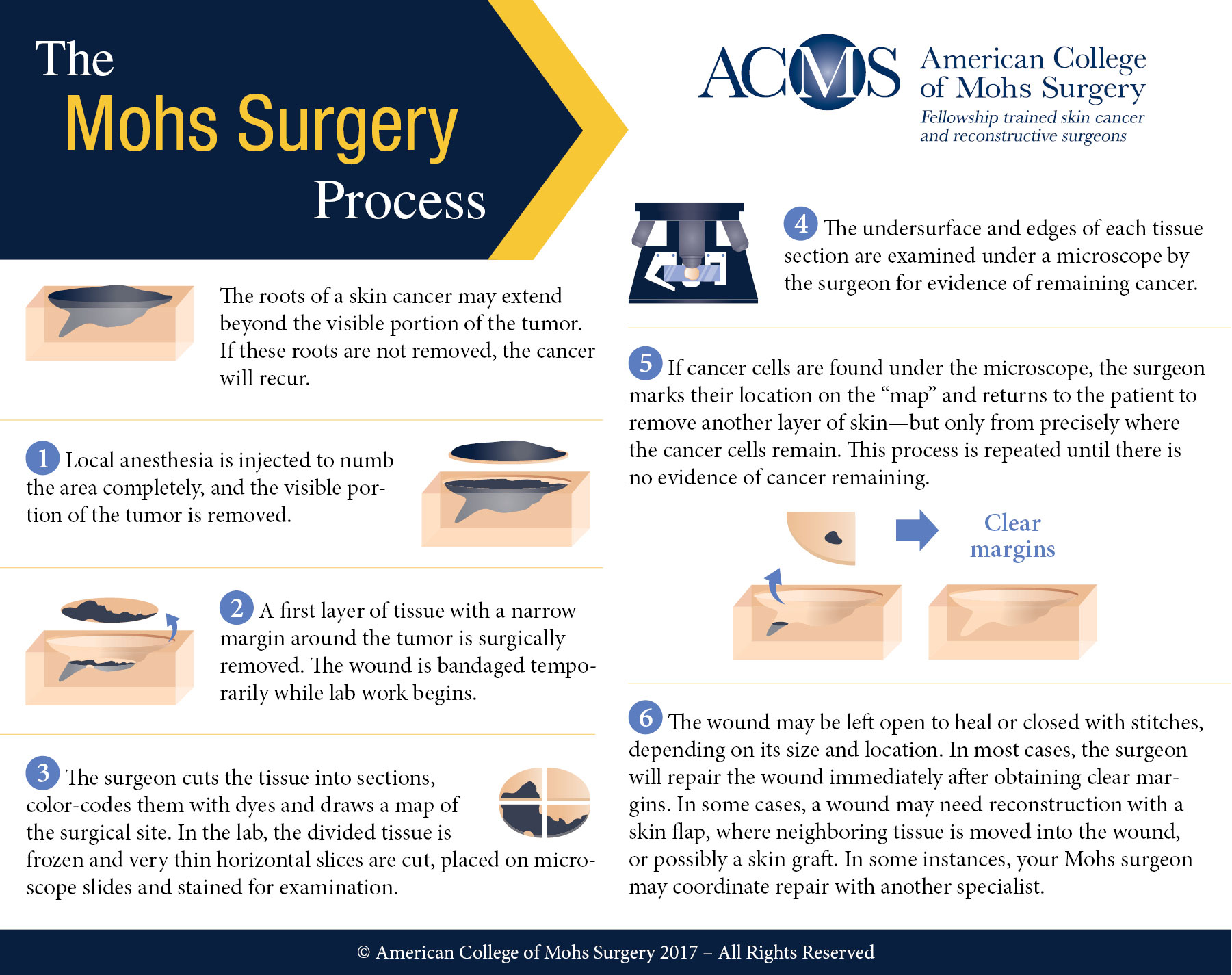The most advanced treatment for skin cancer
Mohs surgery is an advanced surgical technique that has the highest cure rate for skin cancer.
Want to learn even more? Visit our FAQs page.
Mohs surgery is used primarily to treat the two most common types of skin cancer: basal cell carcinoma and squamous cell carcinoma. Dr. Frederic Mohs originally developed the technique in which one physician serves in three distinct roles as cancer surgeon, pathologist, and reconstructive surgeon. Mohs surgery differs from all other skin cancer treatment methods because it combines intraoperative microscopic examination of the cancer with detailed mapping of the entire three-dimensional surgical margin. This precision allows board-certified, fellowship-trained Anir Dhir, M.D. to remove only tissue involved with cancer, with a cure rate of over 99.5%.
Dr. Dhir performs the surgery in our state-of-the-art office while you are awake. Local anesthesia, and sometimes a mild oral sedative, are used to keep you comfortable throughout the procedure. He removes the visible skin cancer along with a thin rim (“margin”) of surrounding skin. A bandage is placed, and you are allowed to relax, and even eat or drink, while our in-house laboratory prepares slides for examination. Dr. Dhir checks the edges of the specimen for cancer cells using a microscope. If additional cancer cells are seen, more tissue is removed from precisely the area involved with cancer. Once Dr. Dhir confirms that all cancer has been removed, he utilizes plastic surgical techniques to reconstruct the wound to minimize scarring and give you the most natural result. The wound may be closed with stitches, a flap, or a graft. In some cases, a wound may be allowed to heal on its own.
The purpose of any cancer treatment is to remove all traces of tumor. Cancer roots are often hidden below the surface of the skin and are easily missed with traditional treatments. Unfortunately, all non-Mohs techniques (e.g. scraping and burning, standard excision, and radiation) rely on the unassisted human eye to determine the extent of disease. As a result, these less accurate techniques are associated with cure rates of 90-94% or less, meaning they fail to cure the cancer in at least one out of every ten to twenty treatments. Non-Mohs approaches also lead to repeat surgeries in as many as 1 in 5 cases, because the physician is effectively guessing where the true cancer margins lie.
By contrast, the cure rate at Arizona Mohs Surgery & Dermatology with Mohs surgery is over 99.5%, so the risk of a treatment failure is reduced to less than one in 200 surgeries.
Because Mohs surgery is so precise, the amount of tissue removed is also minimized, resulting in smaller wound which requires smaller reconstruction and heals more quickly.
We are committed to providing the highest quality and safest care at the lowest possible cost.
Our surgeries are performed entirely under local anesthesia in our outpatient office that was designed and built specifically for Mohs surgery using the best U.S.- and German-manufactured equipment and instruments. By focusing on office-based care without putting you to sleep, we eliminate the traditional costs of an ambulatory surgery center or hospital, and the potential risks of intravenous / general anesthesia and alternative therapies such as radiation. Our approach can reduce the cost of a single skin cancer surgery by several hundred or even a few thousand dollars. Dr. Dhir examines the tissue himself while you wait to make sure that the cancer has been completely removed before performing any needed reconstruction. Therefore, a single visit is generally sufficient, and there are no additional pathologist costs in the vast majority of cases. The entire visit (consultation, preparation, anesthesia, excision, tissue examination, and reconstruction) typically lasts 3 to 5 hours. Much of that time is spent waiting comfortably while we prepare and examine the tissue.
Mohs surgery is the gold standard for cancers located in cosmetically or functionally critical areas such as the face, neck, scalp, and hands. It is also the best approach for non-facial tumors measuring at least 2 cm in diameter, as well as aggressive or rapidly growing cancers and those with ill-defined edges on clinical examination. Because Mohs surgery is more accurate than any other approach, many cancers are sent to Dr. Dhir after failing other attempts at therapy. These “recurrent” cancers may be more serious and often significantly larger than they appear on the surface. The same is true for large or neglected tumors, and those arising in patients with a history of cigarette smoking. Please be advised that these tumors typically require more time and effort to cure, and may occasionally need more than one surgery and/or occasional referral to other specialists if deeper structures (e.g. muscle, bone, cartilage, nerves, tear ducts, the inside of the nose) are involved with cancer. Also, tumors at higher risk for “metastasis” (spread to internal organs) may require additional treatment, such as lymph node dissection, radiation therapy, chemotherapy, or immunotherapy, even after microscopically clear margins are obtained.
Dr. Dhir is one of the most experienced skin cancer surgeons in the country, having performed 43,000 Mohs procedures since 1999. His friendly, compassionate team has worked together for many years, and they are committed to your health, comfort, and a positive experience.

